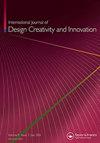非功能仿生:利用自然模式激发注意力反应
IF 2.5
Q4 ENGINEERING, MANUFACTURING
International Journal of Design Creativity and Innovation
Pub Date : 2018-04-03
DOI:10.1080/21650349.2016.1246204
引用次数: 1
摘要
摘要自然重现模式源于混乱,在自然界中普遍存在。这些图案的形成受底层几何结构的控制或产生。仿生是对自然结构、过程和系统的研究,作为设计挑战的模型和解决方案,并被广泛用于解决当代工程的许多问题。许多学者现在认为美学源于模式识别,因此,审美偏好可能是个体识别自然模式并与之互动的结果。这项研究的目的是调查特定的自然发生的模式类型(螺旋、分支和分形模式)对用户行为的影响;研究这种模式控制和影响个体如何与周围环境互动的潜力。结果表明,自然模式的基本几何结构有可能诱导注意力反应达到统计学显著水平。本文章由计算机程序翻译,如有差异,请以英文原文为准。
Non-functional biomimicry: utilizing natural patterns in order to provoke attention responses
Abstract Natural reoccurring patterns arise from chaos and are prevalent throughout nature. The formation of these patterns is controlled by, or produces, underlying geometrical structures. Biomimicry is the study of nature’s structure, processes and systems, as models and solutions for design challenges and is being widely utilized in order to address many issues of contemporary engineering. Many academics now believe that esthetics stem from pattern recognition, consequently, esthetic preference may be a result of individuals recognizing, and interacting with, natural patterns. The goal of this research was to investigate the impact of specific naturally occurring pattern types (spiral, branching, and fractal patterns) on user behavior; investigating the potential of such patterns to control and influence how individuals interact with their surrounding environment. The results showed that the underlying geometry of natural patterns has the potential to induce attention responses to a statistically significant level.
求助全文
通过发布文献求助,成功后即可免费获取论文全文。
去求助
来源期刊

International Journal of Design Creativity and Innovation
ENGINEERING, MANUFACTURING-
CiteScore
3.80
自引率
27.80%
发文量
15
期刊介绍:
The International Journal of Design Creativity and Innovation is an international publication that provides a forum for discussing the nature and potential of creativity and innovation in design from both theoretical and practical perspectives. Design creativity and innovation is truly an interdisciplinary academic research field that will interest and stimulate researchers of engineering design, industrial design, architecture, art, and similar areas. The journal aims to not only promote existing research disciplines but also pioneer a new one that lies in the intermediate area between the domains of systems engineering, information technology, computer science, social science, artificial intelligence, cognitive science, psychology, philosophy, linguistics, and related fields. The journal covers, but is not restricted to, the following topics: ·Theories on Design Creativity and Innovation ·Cognition of Design Creativity ·Innovative Process ·Inventive Process ·Analogical Reasoning for Design Creativity and Innovation ·Design Synthesis ·Method and Tools for Design Creativity and Innovation ·Representation of Design Creativity and Innovation ·Education for Design Creativity and Innovation ·Concept Generation and Inspiration.
 求助内容:
求助内容: 应助结果提醒方式:
应助结果提醒方式:


